Archive for month: October, 2023
“Opening Ceremony of the Exhibition: Beholding the Shooting Stars — The 100th Anniversary of the Publication of Call to Arms” and “Academic Symposium on Lu Xun’s Literature and Chinese Language and Culture” were successfully held at the University of Macau.
/in Article, News, News Letter /by Ho Sok Fong sokfonghoOn October 20, 2023, the “Opening Ceremony of the Exhibition: Beholding the Shooting Stars — The 100th Anniversary of the Publication of Call to Arms” and the “Academic Symposium on Lu Xun’s Literature and Chinese Language and Culture” were held, which were organized by the Lu Xun Museum in Beijing (the Memorial Hall of the New Culture Movement in Beijing) and the University of Macau (UM), and co-organized by the UM Library, the Centre for Chinese History and Culture (CCHC) of UM, and Research Centre for Humanities in South China of UM. The opening ceremony of the exhibition was held in the Sky Garden on 2/F of the Library (E2) of UM, followed by a symposium in the conference room of the Humanities and Social Sciences Building (E21A) of UM, where many scholars, teachers and students gathered to explore the masterpiece of Mr. Lu Xun, a great master of literature, and to discuss Lu Xun’s literature from the angle of Chinese language and culture.
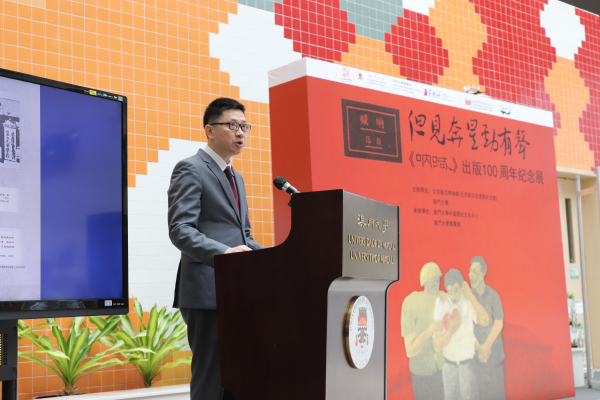 Huang Zhihu, Deputy Director of the Research Office of the Liaison Office of the Central People’s Government in the Macao S.A.R.
Huang Zhihu, Deputy Director of the Research Office of the Liaison Office of the Central People’s Government in the Macao S.A.R.
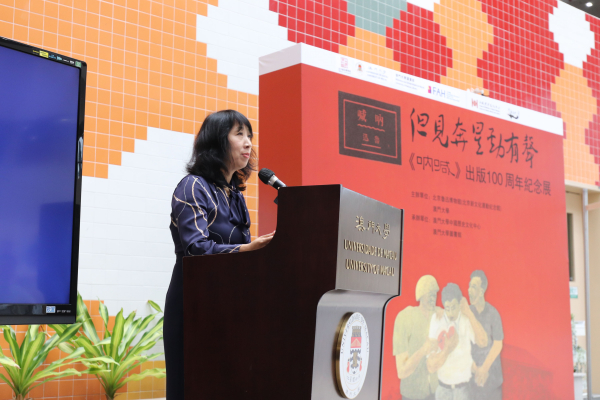 Jiang Yixin, Deputy Director of the Lu Xun Museum (Beijing New Culture Movement Memorial Museum)
Jiang Yixin, Deputy Director of the Lu Xun Museum (Beijing New Culture Movement Memorial Museum)
During the opening ceremony of the exhibition “The 100th Anniversary of the Publication of Call to Arms”, Huang Zhihu, Deputy Director of the Research Office of the Liaison Office of the Central People’s Government in the Macao S.A.R., firstly delivered a speech in which he said that, with the support of our country, Macao is accelerating the construction of “One Center”, “One Platform” and “One Base”. In this exhibition, visitors were able to witness Mr. Lu Xun’s precious handwriting, and to feel the national soul, patriotism and literary creativity from a close distance, which is conducive to promoting Macao’s humanistic culture construction, academic research and exchange of ideas. Then, Jiang Yixin, Deputy Director of the Lu Xun Museum (Beijing New Culture Movement Memorial Museum), delivered a speech, in which she said that in Call to Arms, Lu Xun’s unique and insightful literary reflections on the times, history, nationalism and human nature have reached a remarkable high altitude and have had far-reaching impacts. It is meaningful that this event can be held in Macao which is at the forefront of combining Chinese and Western cultures. Zhu Shutong, Director of CCHC of UM, said, A Madman’s Diary is the first modern vernacular novel in China, which opened up the real vernacular written language writing, and Lu Xun played an important role in shaping the soul of Chinese people. By focusing on the whole process of the birth of Call to Arms and through in-depth academic research, we can better grasp the significance of Lu Xun’s modern Chinese writing to Chinese culture. After the official announcement of the opening of the exhibition, Qin Suyin, Deputy Director of the Research Department of the Lu Xun Museum (Beijing New Culture Movement Memorial Museum), finally introduced the contents of the exhibition to the audience.
After the opening ceremony, guests and scholars moved to the conference room for the Academic Symposium on Lu Xun’s Literature and Chinese Language and Culture. At the beginning, two research librarians from the Lu Xun Museum in Beijing, Jiang Yixin and Liu Jing, gave speeches on the topics of “From ‘call to arms’ to Call to Arms: On the Occurrence of Lu Xun Literature of ‘Sound the Alarm’” and “‘Jin Xinxian’ in Call to Arms-Preface”. At the discussion session, several doctoral students from UM expressed their own opinions and made brilliant speeches with new perspectives. At the end of the symposium, Zhu Shoutong concluded that Lu Xun’s research is not only related to the study of social phenomenon, but also the study of risk. Teenagers of UM are expected to study hard to establish a solid foundation, have the courage to take risks and climb the mountain in the path of study like Lu Xun.
Guests who attended the symposium were included Jiang Yixin, Deputy Director of Beijing Lu Xun Museum (Beijing New Culture Movement Memorial Museum), Research Librarian, Editor-in-Chief of Lu Xun Research Monthly; Liu Jing, Director of the Department of Display and Exhibition of Beijing Lu Xun Museum (Beijing New Culture Movement Memorial Museum); Qin Suyin, Deputy Director of the Research Office of Beijing Lu Xun Museum (Beijing New Culture Movement Memorial Museum), Research Librarian; Huang Zhihu, Deputy Director of the Research Office of the Liaison Office of the Central Government in Macao SAR; Wu Jianzhong, UM Librarian; Leong Tak Hoi, Assistant Librarian; Tam Sik Chung, Acting Master of the Shiu Pong College, UM; Jiang Yi, Representative of the Henry Fok Pearl Jubilee College, UM; Zhang Yue, Assistant Dean of the FAH, UM; Zhu Shoutong, Director of CCHC of UM; Cheang Neng Ian, Vice Director of CCHC of UM; Chen Zhong, Vice Director of the Confucius Institute of UM; Zhang Jian, Chair Professor of Chinese Language and Literature, Wang Sihao, Associate Professor, Liu Hongyong, Associate Professor, Wei Chu Xiong, Emeritus Professor of the Department of History of UM, and Lao Keng Chong, Part-time Lecturer of CCHC of UM and so on.
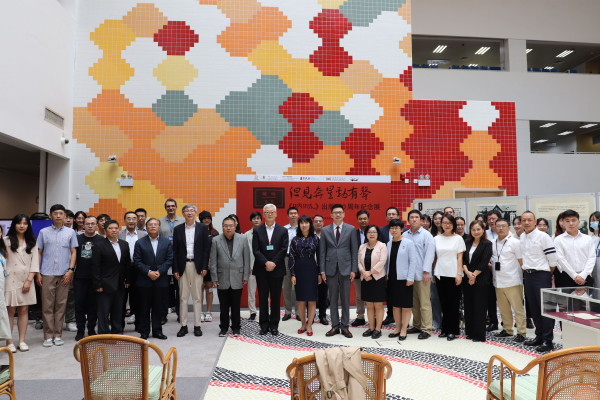
UM inaugurates Suao Pavilion and kicks off Festival of Chinese Culture
/in Article, News, News Letter /by Tong Ho Kei stephenietongThe University of Macau (UM) held the inauguration ceremony of the Suao Pavilion and the opening ceremony of the Second Festival of Chinese Culture. The event was attended by a total of 60 guests, including government officials and representatives of UM and other associations. The Suao Pavilion was built through donations by the Jiangsu Overseas Friendship Association and the Suzhou Overseas Friendship Association. It is located on the lawn outside the Cultural Building at UM. The pavilion symbolises the cultural exchanges between Jiangsu and Macao, as well as the heritage of Chinese history and culture. It not only enriches the cultural landscape of the campus, but also demonstrates the harmonious coexistence of the Jiangnan and Lingnan cultures.
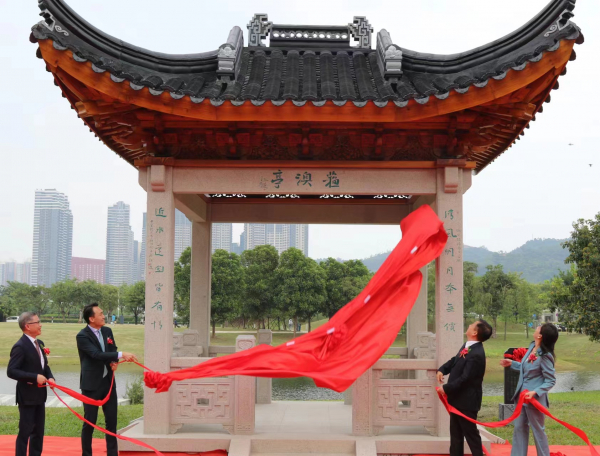
The inauguration ceremony of UM’s Suao Pavilion
On the other hand, the event kicked off the Second Festival of Chinese Culture organised by the Centre for Chinese History and Culture of UM. The festival has three components: 1) lectures, promotion, and education on Chinese history and culture; 2) exhibitions, performances, and demonstrations on Chinese history and culture; and 3) forums, seminars, and debates on Chinese culture and Macao culture. In addition, the Henan Research Institute of Culture and History was invited to be the co-organiser of the festival, in the hope of enhancing the academic quality of the forums with its rich academic resources. The university will be holding nearly 100 activities with its partner universities during the festival.
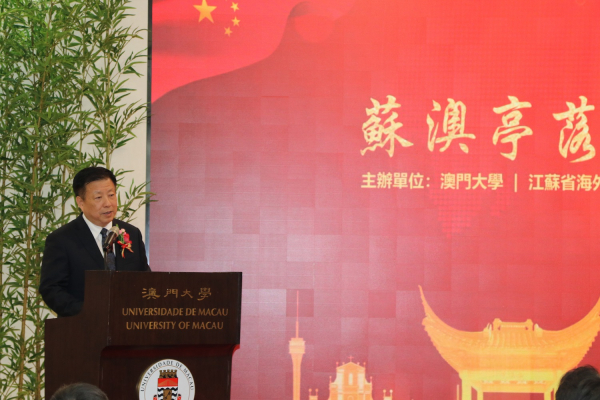
Fang Wei
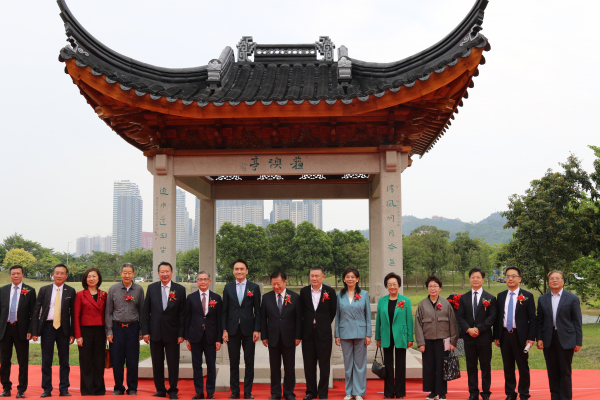
A group photo
澳門焦點報:情連蘇澳 姿吟盛世|澳門焦點報_compressed
澳門大學官方微信:澳大有座蘇澳亭,座落在校園中央
澳大微新聞:澳大校園裡的江南,你打卡了嗎?
List of activities of The First Chinese Cultural Festival
/in Uncategorized /by Deng Nanliang mc24101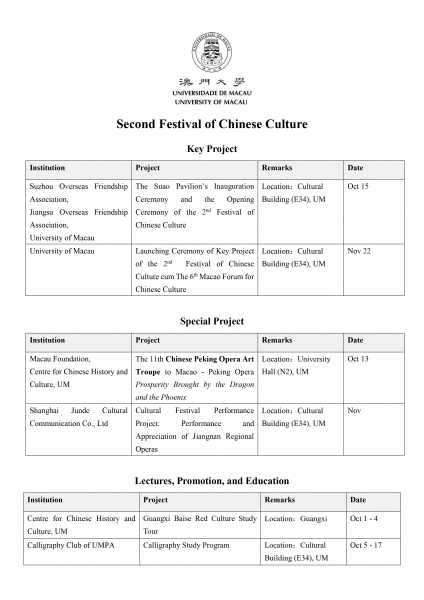
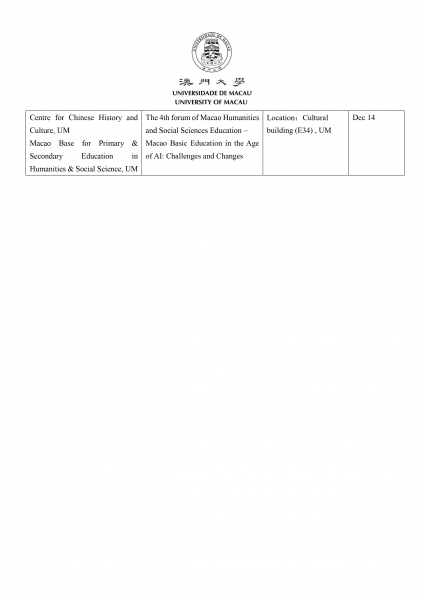
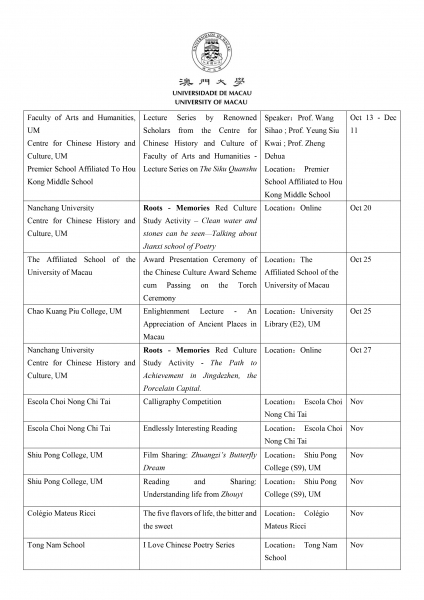
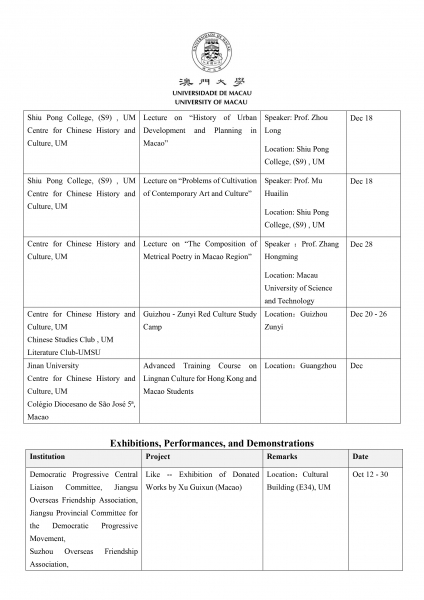
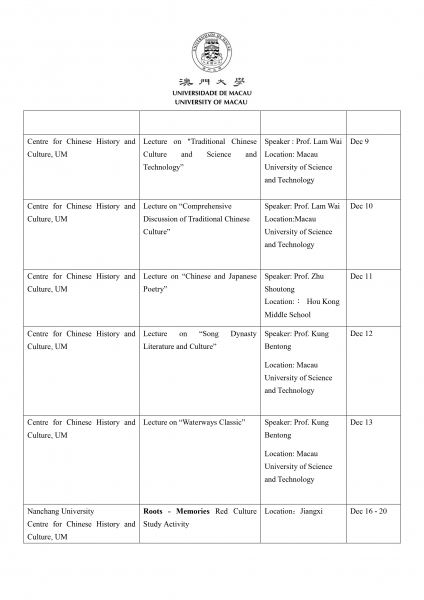
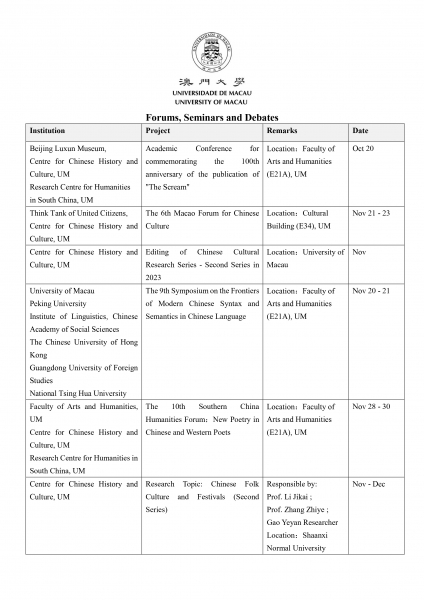
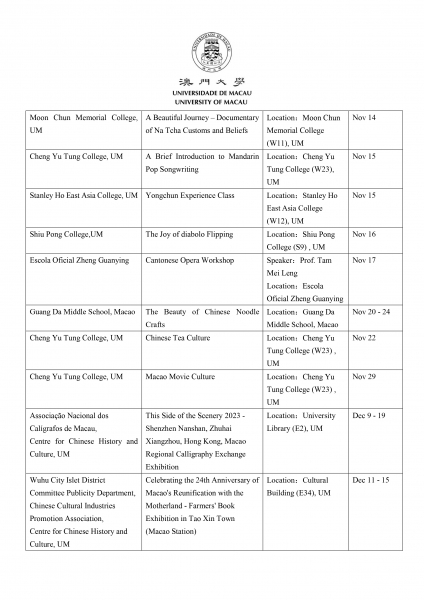
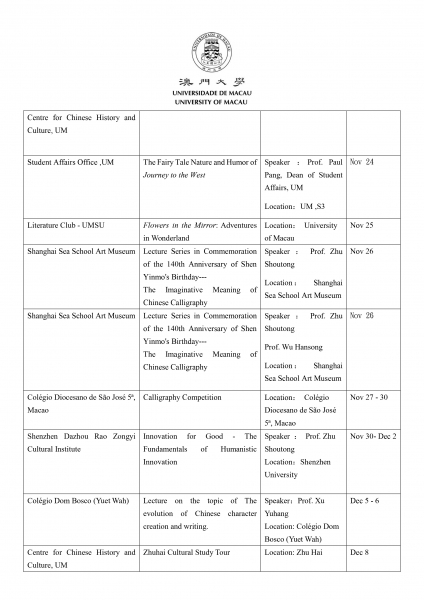
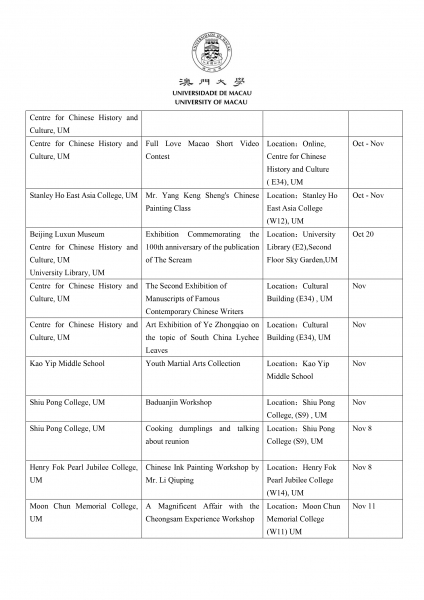
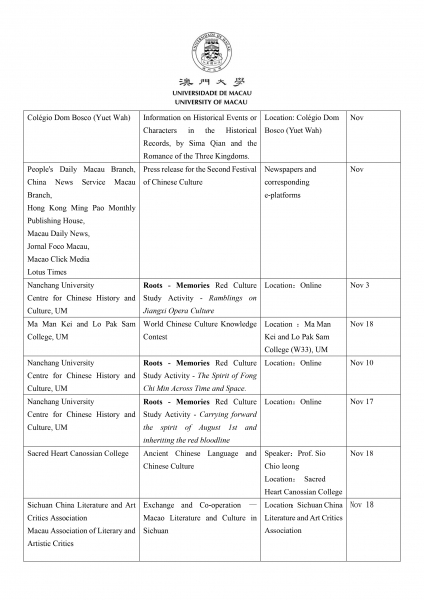
Forging Red Memory Together: The Study Group of University of Macau learn the Historical and Cultural Heritage of Baise in Guangxi Province
/in Article, Event, News /by Ho Sok Fong sokfonghoFrom 30th September to 4th October 2023, the “Guangxi •Baise Red Culture Study exchange trip”, jointly organized by the University of Macau (UM), the Faculty of Arts and Humanities ( FAH) and the Centre for Chinese History and Culture ( CCHC), was carried out successfully. With the great support from the UM, the study group received warm welcome from the people of Guangxi. There were 29 students and teachers from the postgraduate programme of Chinese History and Culture of the UM, Macao Base for Primary & Secondary Education in Humanities & Social Science Base and Macao Chinese Culture Promotion Ambassadors. The purpose of this study group is to allow Macao teachers and students to go close to the mainland of China, to experience the vastness of the country’s culture, and to strengthen the sense of national awareness and national pride. During the five days, the team toured Baise and Guilin successively, visited the Baise Uprising Memorial Park and Yue Dong Provincial Guild, as well as Elephant Trunk Hill, Longji Terraced Fields and Jingjiang Princes’ Palace, etc., to gain an in-depth understanding of the red culture of Guangxi as well as the characteristics of the local folk culture.

On the National Day, the study group visited the Yue Dong Provincial Guild, which was the command headquarters of the Baise Uprising. The brick and wood structure of the ancient building has the artistic tradition and style of the ancient architecture of the South. Later, they visited the large-scale Baise Uprising Memorial Park, which comprehensively displays the narratives of important figures and events related to the Baise Uprising, including the Baise Uprising Memorial Hall, the You River Ethnic Museum, the Baise Uprising Memorial Monument, the Red Army Bridge, the Nange Pavilion, and the Friendship Garden of the Youths of Guangdong and Guangxi, among other important revolutionary historical and cultural resources. The visit allowed many teachers and students from Macao to deeply understand the difficulty of exploring the revolutionary road with Chinese characteristics, and the excellent qualities of the revolutionary team, such as “Perseverance, seeking truth from facts, relying on the masses, and united struggle “, deeply moved the team and gave rise to a sense of national pride.

On 2nd October, the team went to the banks of Guilin’s Li River to see the Elephant Trunk Hill spectacle, The Tabo Pagoda of the Pohyonsa Buddhist temple, the Sanhua Rice Aroma, and the Love Island. Later, they explored the historical and cultural landscape of the Song Dynasty Dong Zhen Gate and the Song Dynasty City Wall remains on the north side of Mulong Lake. From the Baise Uprising a hundred years ago to today’s celebration of the National Day in Guilin, through the mists of time and space of more than 90 years and the ancient and modern gap. We can still clearly see the Guangxi this piece of red land on the lasting charms magnificent picture: from becoming a brigade of the Central Red Army to hold on to the right side of the Youjiang for 20 years, the red flag will not fall, the fire will not go extinct, and are always vividly demonstrated the martyrs of the uprising and the heroism of the saints of the past and the spirit of struggle.

On 3rd October, the team came to Longji in Guilin and visited the World’s Crown of Terraces Longji Terraces and Ping’an Village, enjoying the beautiful scenery of Ping’an Terraces, the Seven Stars Around the Moon, and the Nine Dragons and Five Tigers and so on. During the Golden Autumn Festival, we saw rice ears full of rice like bowing down in salute, just as the people of Guangxi are generally warm and hospitable.

On 4 October, the study group toured one river and four lakes in one day, taking a cruise on the inner section of Guilin’s Li River city, Rong Lake, Gui Lake, Shan Lake and Mulong Lake to see the green mountains and green waters of Guilin. Finally, the team made an in-depth inspection of Duxiu Peak, a 5A National Scenic Area, and the Jingjiang Princes’ Palace. This was the residence of King Zhu Shouqian of Jingjiang, a vassal king of the Ming Dynasty, and is surrounded by one of the best-preserved Ming Dynasty city walls outside the country. The group toured the area, experiencing the Fu and the imperial examinations, travelling through the Ming and Qing dynasties, and seeing the dilapidated walls after the overthrow of the Qing dynasty and restoration of the Ming dynasty and Anti-Japanese War periods. Only the Jingjiang Princes’ Palace under the Duxiu Peak has survived all the ups and downs of the past and has been preserved by the feng shui and Chinese culture trace of the people as the time goes by.

Through this Guangxi-Baise Red Culture Study Group, Macao teachers and students were able to visit the significant history of ancient and modern times, and gained an in-depth understanding and experience of the essence of Guangxi culture, further enhancing their understanding of Guangxi culture. At the same time, this activity also promoted academic exchanges and co-operation between Macao and Mainland cities, promoted Macao’s education and the inheritance and development of local culture, and expanded the influence of Chinese history and culture.
Address: Cultural building (E34), Centre for Chinese History and Culture, University of Macau, Avenida da Universidade, Taipa, Macau, China
